Report

Executive Summary
The luxury goods market continues to shine
The 17th edition of the Bain Luxury Study, published by Bain & Company for Fondazione Altagamma, the trade association of Italian luxury goods manufacturers, analyzed recent developments in the global luxury goods industry, as well as the future outlook.
The luxury industry as tracked by Bain encompasses both luxury goods and experiences. It comprises nine segments, led by luxury cars, luxury hospitality and personal luxury goods, which together account for more than 80% of the total market.
Overall, the luxury market grew 5% in 2018, to an estimated €1.2 trillion globally, with positive performance across most segments.
Sales of luxury cars continued to dominate the market, growing 5% at constant exchange rates to €495 billion. Luxury experiences remained very attractive to consumers, as illustrated by sales growth of luxury hospitality (up 5% from last year), gourmet food and fine dining (up 6%) and luxury cruises (up 7%).
Personal luxury goods segment posts healthy growth
The market for personal luxury goods—the “core of the core” and the focus of this analysis—reached a record high of €260 billion, representing 6% growth (2% at current exchange rates). Worldwide, the personal luxury goods market experienced growth across most regions, driven primarily by more robust local consumption (up 4% globally at current exchange rates). In contrast, purchases among tourists remained flat on average.
Overall, shoes and jewelry were the top luxury growth categories, gaining 7% each, followed by handbags and beauty. Watches remained flat while apparel suffered, mainly due to lackluster sales in the menswear segment.
Chinese consumers’ appetite for luxury remains unrivaled
Chinese consumers led the positive growth trend around the world. Their share of global luxury spending continued to rise (now 33% of the total, up from 32% in 2017), while mainland China’s share rose to 9% (up from 8% in 2017). In mainland China, luxury sales grew 20% to €23 billion, driven by rising demand. Between 2015 and 2018, Chinese consumers’ local spending contributed twice as much growth in absolute value as their spending abroad.
Europe lagged in 2018, as strong currencies limited tourists’ purchasing power. Local consumption was positive overall, despite mixed performance across countries, helping to push retail sales up 3% to €84 billion.
Luxury sales in the Americas reached €80 billion, representing a growth rate of 5%. A positive US economy boosted disposable income and overall luxury spending by local consumers. However, the strong dollar curbed spending by tourists from Asia and Latin America. Canada and Mexico were strong markets in the region, while political uncertainties derailed Brazil’s performance.
In Japan, luxury sales eased slightly, rising 6% to €22 billion. Across the rest of Asia, sales grew 9% to €39 billion. In other areas of the world, growth was flat, with sales holding at €12 billion, mainly due to stagnation in the Middle East.
Increasingly, luxury consumers are shopping online
The retail channel grew 4% in 2018, with three-quarters of that increase coming from same-store sales growth. The wholesale channel grew only 1%, hampered by department store performance and a slowdown among specialty stores facing tough competition from the online channel.
Online luxury shopping continued to accelerate in 2018, growing 22% to nearly €27 billion; it now represents 10% of all luxury sales. The Americas market made up 44% of online sales, but Asia is emerging as a new growth engine for luxury online, slightly ahead of Europe. Accessories remained the top category sold online, ahead of apparel. The beauty and “hard luxury” (jewelry and watches) categories were both on the rise. The biggest online channels for luxury sales were e-tailers, brands’ own websites and retailers’ websites.
Meanwhile, the secondhand market for luxury goods surged to €22 billion on strong growth in Europe and among online platforms.
Luxury consumers are getting younger and more diverse
Luxury brands can no longer deny the influence of younger consumers. Generations Y and Z accounted for 47% of luxury consumers in 2018 and for 33% of luxury purchases. However, they contributed virtually all of the market’s growth, compared with 85% in 2017. To capitalize, luxury brands are adapting to the preferences of younger consumers in terms of product offerings, communication and engagement strategies, and distribution channels.
The luxury industry is also increasingly acknowledging cultural and size preferences. Modest fashion, comprising garments that can be worn by Muslim consumers, accounted for approximately 40% of luxury women’s ready-to-wear in 2018, while “inclusive” fashion, targeted to curvy or plus-size consumers, represented about 20%.
Seven macro trends will shape the market through 2025
Looking ahead, we expect market fundamentals to remain favorable for the personal luxury goods segment, resulting in growth of 3% to 5% per year through 2025, for a total value of €320 billion to €365 billion. However, sociopolitical issues, commercial policies and potential soft recessions could make for a bumpy road in the short term.
Based on our analysis, we identified seven trends that will shape the future of luxury.
Chinese shoppers ramp up their purchasing, especially in China. By 2025, Chinese consumers will account for 46% of the global market (up from 33% in 2018), and they will make half of their purchases at home in China (up from 24% in 2017).
Digital permeates every purchase. By 2025, the online channel will represent 25% of the market’s value, up from 10% today. Approximately half of all luxury purchases will be digitally enabled thanks to new technologies along the value chain, and nearly all luxury purchases will be influenced by online interactions.
Network consolidation redefines the store of the future. Reduced foot traffic at physical stores will lead to consolidation in retail networks, similar to what has already happened in sectors such as music, books and consumer electronics. The role of the store will evolve from a simple point of sale to a true touchpoint for consumer engagement.
The influence of younger consumers grows. New generations will be the primary engine of growth for the luxury market in the coming years. Generations Y and Z will represent approximately 55% of the 2025 market and will contribute 130% of market growth between now and then, offsetting the decline in sales among older generations.
Cultures and subcultures drive consumption trends. Evolving cultures and subcultures (religious, ethnic and others) will gain increasing influence. Luxury brands will need to acknowledge and address these groups to remain relevant.
One market will serve “markets of one.” Brands in 2025 will see a blurring of typical competitive boundaries. The standard model of growth—in which brands either become a specialist in a category or diversify across a broader set of products and services—will be taken to the extreme as companies strive to address individual consumers’ unique needs.
Nimble becomes the new black. EBIT margins rose from 19% in 2017 to 20% in 2018, confirming the recent trend of higher profitability. However, digital disruption will continue to affect brands’ P&Ls, and profitability should stabilize. Brands will need to become more agile in order to sustain their profitability levels.
To weather these disruptions, brands should focus on three priorities:
- Proactively develop dedicated strategies to address market trends.
- Design a distinctive winning formula based on consumer needs. (Generic, “plug-and-play” formulas are no longer enough.)
- Win over younger consumers as a key engine for future market growth.
Underpinning all of these strategies are new technologies, which will play a crucial role as a fundamental enabler across the luxury value chain through 2025.
1. Luxury spending trends in 2018
- The global luxury market tracked by Bain & Company comprises nine segments, including luxury cars, personal luxury goods, luxury hospitality, fine wines and spirits, gourmet food and fine dining, fine art, high-end furniture and housewares, private jets and yachts, and luxury cruises. Overall, the luxury market gained 5% in 2018, rising to an estimated €1.2 trillion, with most segments growing in real terms.
- Luxury cars, luxury hospitality and personal luxury goods together accounted for more than 80% of the total market.
- Sales of luxury cars continued to dominate the market, growing 5% to €495 billion (a slight decline in the growth rate vs. 2017). Within the luxury car market, the aspirational segment outperformed.
- Luxury hospitality experienced positive growth in real terms, gaining 5%. Sales of luxury cruises increased 7%—the highest growth rate of all luxury segments. The “expedition” category in particular boomed in 2018.
- Sales of high-end food grew 6% from last year. Of particular importance was the “ethical nutrition” trend, reflected by consumers’ desire for authenticity, quality, freshness and transparency regarding a product’s origins.
- Fine wines and spirits grew 4% on average, with polarized performance across wines (low single-digit growth) and spirits, which gained momentum due to increased demand from exclusive clubs and growing interest in craft spirits.
- Yacht sales posted lackluster performance, despite rising interest from Chinese buyers. The private jet market continued to contract, suffering from cannibalization from the secondhand market.
- Personal luxury goods outperformed the overall market in 2018, climbing 6% to reach a record high of €260 billion.
The global luxury market grew to nearly €1.2 trillion in 2018, up 5% from 2017


The personal luxury goods segment outperformed other luxury segments in 2018


After a pause in 2016, the personal luxury goods market returned to a “new normal” of moderate growth



Claudia D'Arpizio: The State of the Luxury Goods Market
Bain Partner Claudia D'Arpizio discusses the positive outlook in the luxury market after a couple of years of stagnation.
2. Regional highlights
- Worldwide, the personal luxury goods market experienced growth across most regions. Europe remained the top region for sales, followed by the Americas, Asia (including mainland China), Japan and the rest of the world.
- Chinese consumers led the positive growth trend, with a 33% share of global luxury spending (up from 32% in 2017). Between 2015 and 2018, purchasing by Chinese consumers in mainland China contributed twice as much growth in absolute value as their spending abroad.
- Europe experienced moderate growth in sales in 2018. Local consumption was positive overall, helping to boost retail sales 3% (1% at current exchange rates) to €84 billion. But a deceleration in tourist spending had a major impact across European markets. Data from Global Blue—a company that tracks tax-free shopping transactions—shows that most major markets, including Germany, the UK, Spain and Italy, saw a substantial contraction in tax-free spending, as strong currencies dampened tourist shopping. France remained a bright spot, with 2% growth in tax-free transactions.
- Luxury sales in the Americas posted a growth rate of 5% (–1% at current exchange rates), rising to €80 billion. A positive US economy boosted disposable income and overall luxury spending by local consumers. However, the strong dollar curbed spending by tourists from Asia and Latin America. Canada and Mexico were strong markets in the region, while political uncertainties derailed Brazil’s performance.
- Luxury purchases in Japan eased compared with 2017 but still hit €22 billion, representing 6% growth (3% at current exchange rates). Japan enjoyed increased consumption by tourists, who took advantage of affordable flights to the main shopping cities of Tokyo, Kyoto and Osaka.
- Across the rest of Asia, sales rose 9% (11% at current exchange rates) to €39 billion, thanks to dynamic growth in local consumption in South Korea and brisk growth in Singapore, Thailand, Taiwan, Vietnam and the Philippines. Inflows of Chinese tourists benefited the entire region, particularly Hong Kong and Macau.
- In other areas of the world, growth was flat, holding at €12 billion. Consumers in the Middle East saw constrained disposable income due to a drop in oil prices and a recent government spending restriction. Additionally, the region’s turbulent geopolitical situation has reduced tourist volume.
Europe remained the top region for luxury sales


Chinese consumers accounted for 33% of global luxury purchases


Since 2015, luxury spending in China has grown twice as fast as spending by Chinese consumers abroad


Strong European currencies dampened shopping among tourists, except in France


3. Distribution trends
- Wholesale remained the largest channel for luxury goods, accounting for 62% of all sales. Yet the retail channel continued growing steadily—rising 4% in 2018—as companies increasingly seek to control the experience they deliver to customers. Of that gain, 1% came from new-store openings and the remaining 3% came from same-store sales growth. Wholesale grew only 1%, as specialty stores faced tough competition from the online channel. Department stores, meanwhile, saw a bifurcation between the struggling accessible segment and the recovering high-end segment.
- Off-price stores and airport stores continued to log strong growth, both gaining 7%.
- Online remained the fastest-growing channel, increasing 22% and reaching 10% penetration of luxury sales globally. The Americas contributed 44% of global online luxury sales—which totaled €27 billion overall—but growth was particularly strong in Europe and Asia. Accessories remained the top category sold online, ahead of apparel, while beauty and hard luxury (jewelry and watches) were both on the rise. The biggest online channels for luxury sales were e-tailers (39%), brands’ own websites (31%) and retailers’ websites (30%).
- The secondhand market for luxury goods rose to €22 billion in 2018, propelled by strong growth in Europe, which makes up more than half of this market, as well as by growth among highly specialized online platforms. Watches and jewelry are the primary categories in the secondhand market, accounting for 80% of all purchases.
Wholesale remained the dominant channel for luxury goods, but owned retail continues to grow faster


The off-price, online and airport channels continue to outperform

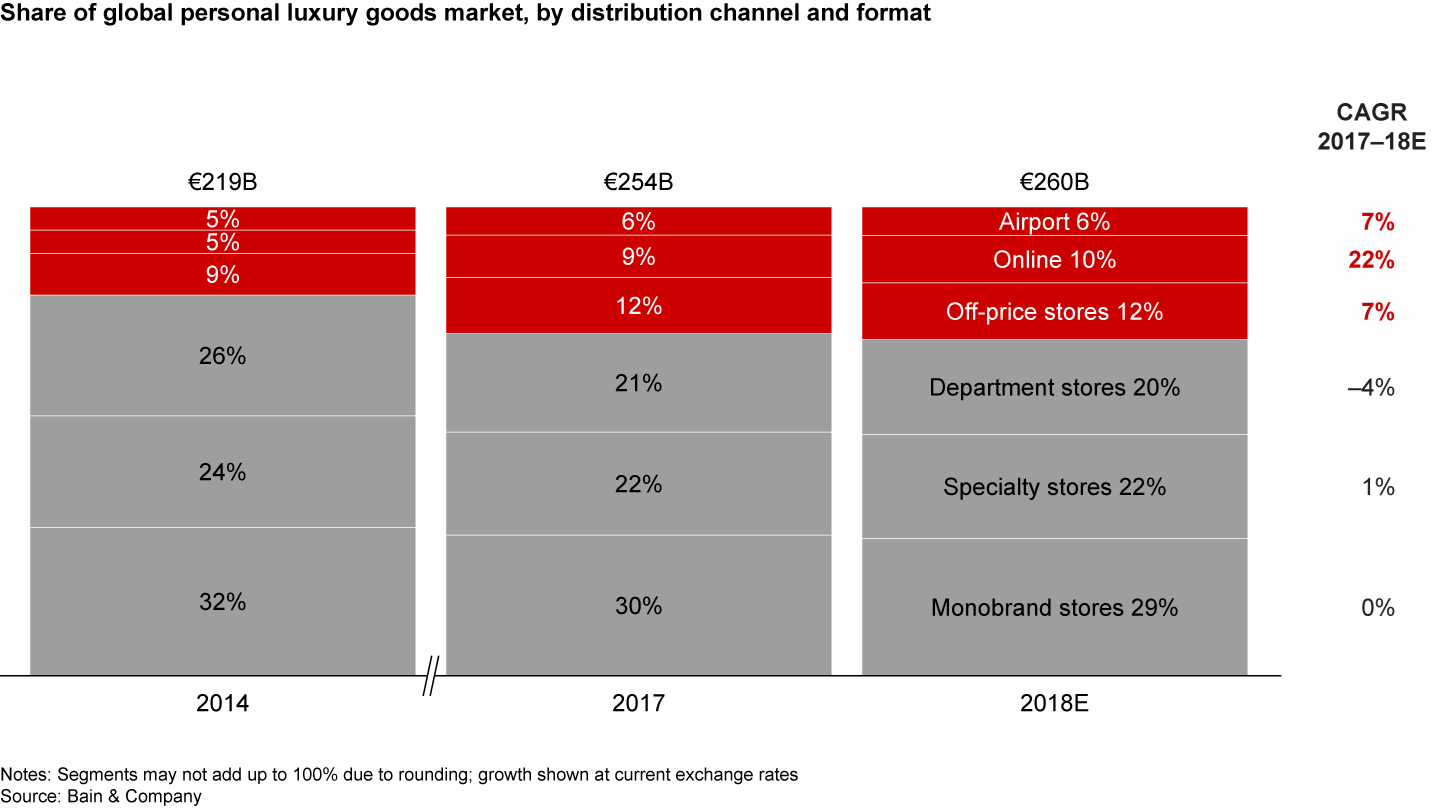
Online luxury posted another year of double-digit growth, reaching 10% of the total market

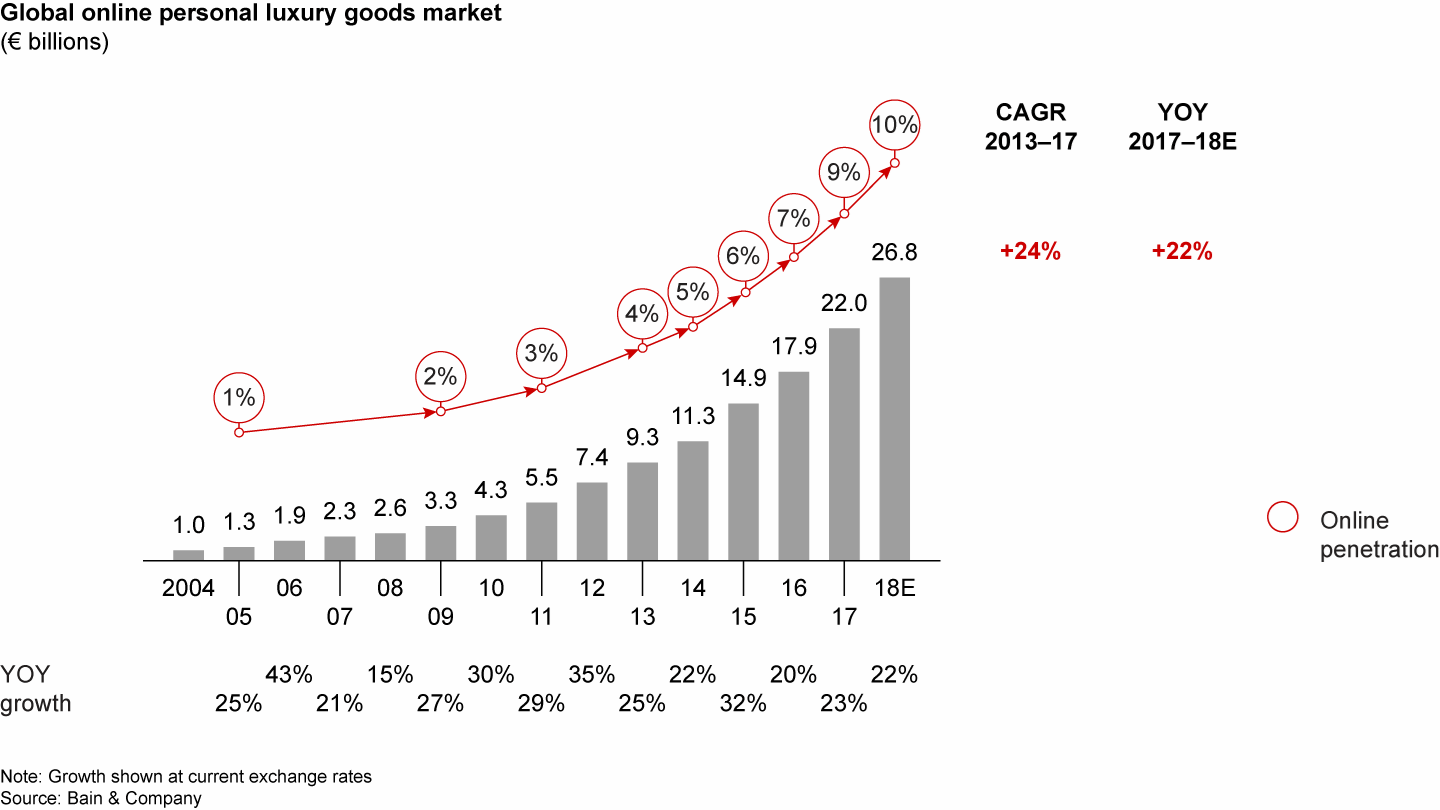
Online sales were most prominent in the Americas, but Asia grew faster; accessories remained the top online category and e-tailing the top business model


The secondhand market for personal luxury goods has grown 9% per year since 2015



Federica Levato: The Changing Role of the Luxury Store
Brands can capitalize on the growth opportunities in the industry by investing more in their stores.
4. Individual category performance and customer shifts
- Accessories remained the largest and fastest-growing category, representing one-third of the total personal luxury goods market and gaining 4% in 2018.
- Apparel, beauty and handbags continued to make up the bulk of global luxury purchases, amounting to €60 billion, €56 billion and €51 billion, respectively.
- Shoes and jewelry were the top growth categories at 7% each, followed by handbags and beauty. Watches remained flat while apparel suffered, mainly due to lackluster sales in the menswear segment.
- Generations Y and Z accounted for 47% of luxury consumers and 33% of luxury purchases in 2018. However, they contributed virtually all of the market’s growth, compared with 85% in 2017.
- In response, the luxury market is adapting to the preferences of younger consumers, evolving and innovating in terms of product offerings, communication and engagement strategies, and distribution channels. Generation Z, despite being a smaller portion of the market (2% in 2018), is already demonstrating highly differentiated preferences from previous generations. For instance, Gen Z consumers are more “individualist” (looking for products that convey their unique personality); more willing to shop in physical stores (but expecting a digitally enhanced experience); and more logo-driven, though they exhibit little brand loyalty.
- The luxury industry is also increasingly acknowledging cultural and size preferences. Modest fashion, including garments specifically designed for Muslim consumers and other types of less-revealing designs, accounted for approximately 40% of luxury women’s ready-to-wear in 2018. “Inclusive” fashion, targeted to curvy or plus-size consumers, represented about 20% of luxury women’s ready-to-wear, with brands producing more one-size garments, larger sizes and clothing with looser, more accommodating fits.
Accessories remained the largest and fastest-growing personal luxury goods category


Shoes and jewelry were the fastest-growing product categories, followed by handbags and beauty; apparel contracted


Generations Y and Z represented 47% of global personal luxury goods consumers in 2018, accounting for one-third of sales


5. Outlook for the future
- We expect growth to continue at an annual rate of 3% to 5% through 2025, with the market for personal luxury goods reaching €320 billion to €365 billion.
- By 2025, Chinese consumers will make up 46% of the global market (up from 33% in 2018), and they will make half of their purchases at home in China (up from 24% in 2017).
- Younger generations will be the primary engine of growth in the coming years. Generations Y and Z will represent approximately 55% of the 2025 luxury market and will contribute 130% of market growth between now and then, offsetting a decline in spending by older consumers.
- By 2025, the online channel will represent 25% of the market’s value, up from 10% today. Approximately half of all luxury purchases will be digitally enabled as a result of new technologies along the value chain, such as virtual reality and mobile payments, and nearly all luxury purchases will be influenced by online interactions.
- Confirming the recent trend of higher profitability, EBIT margins rose from 19% in 2017 to 20% in 2018. However, digital disruption will continue to affect brands’ P&Ls, and profitability should stabilize going forward. Brands will need to become more nimble in order to sustain their profitability levels.
The global personal luxury goods market should grow 3%–5% per year through 2025

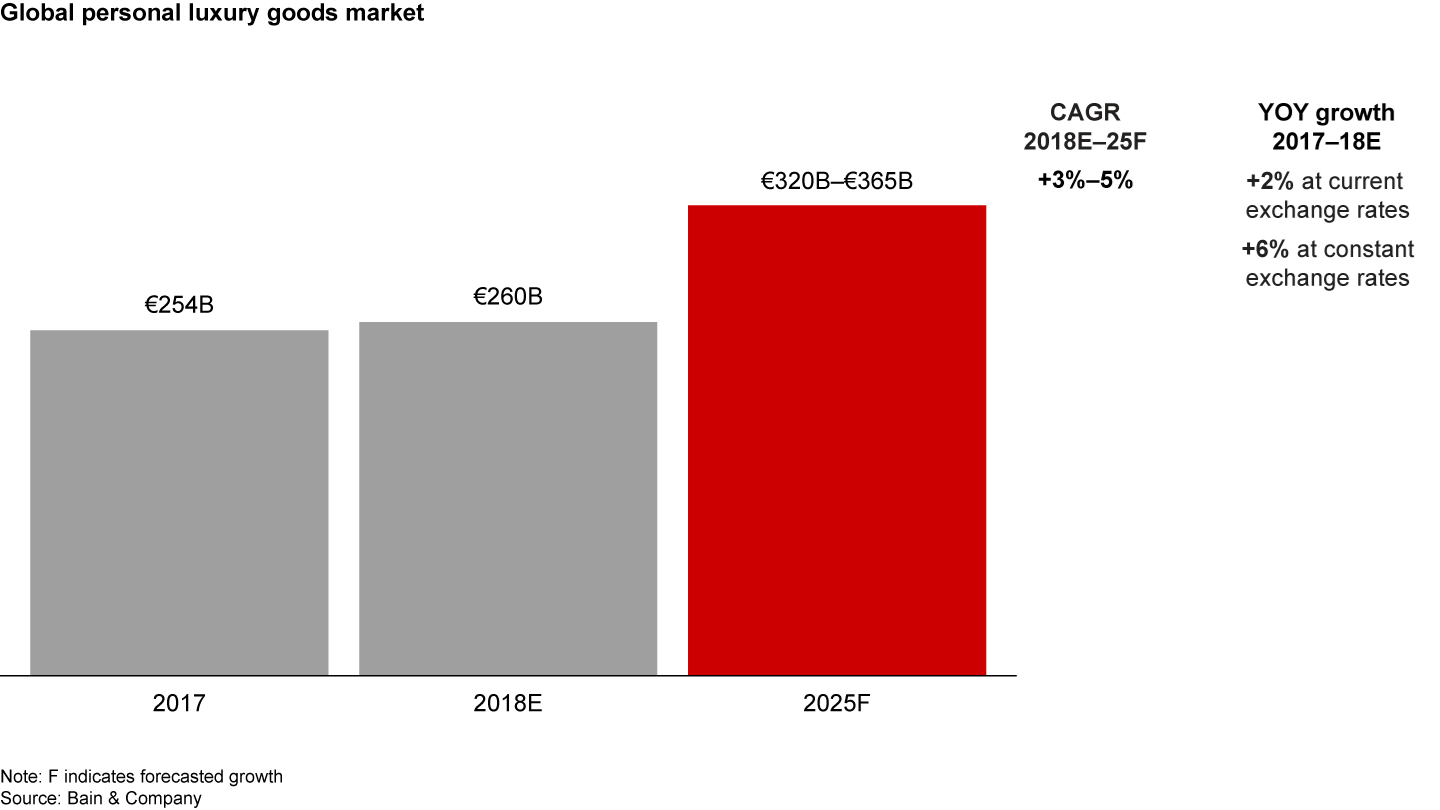
China and Chinese consumers will continue to drive growth


Chinese consumers will account for 46% of the personal luxury goods market by 2025

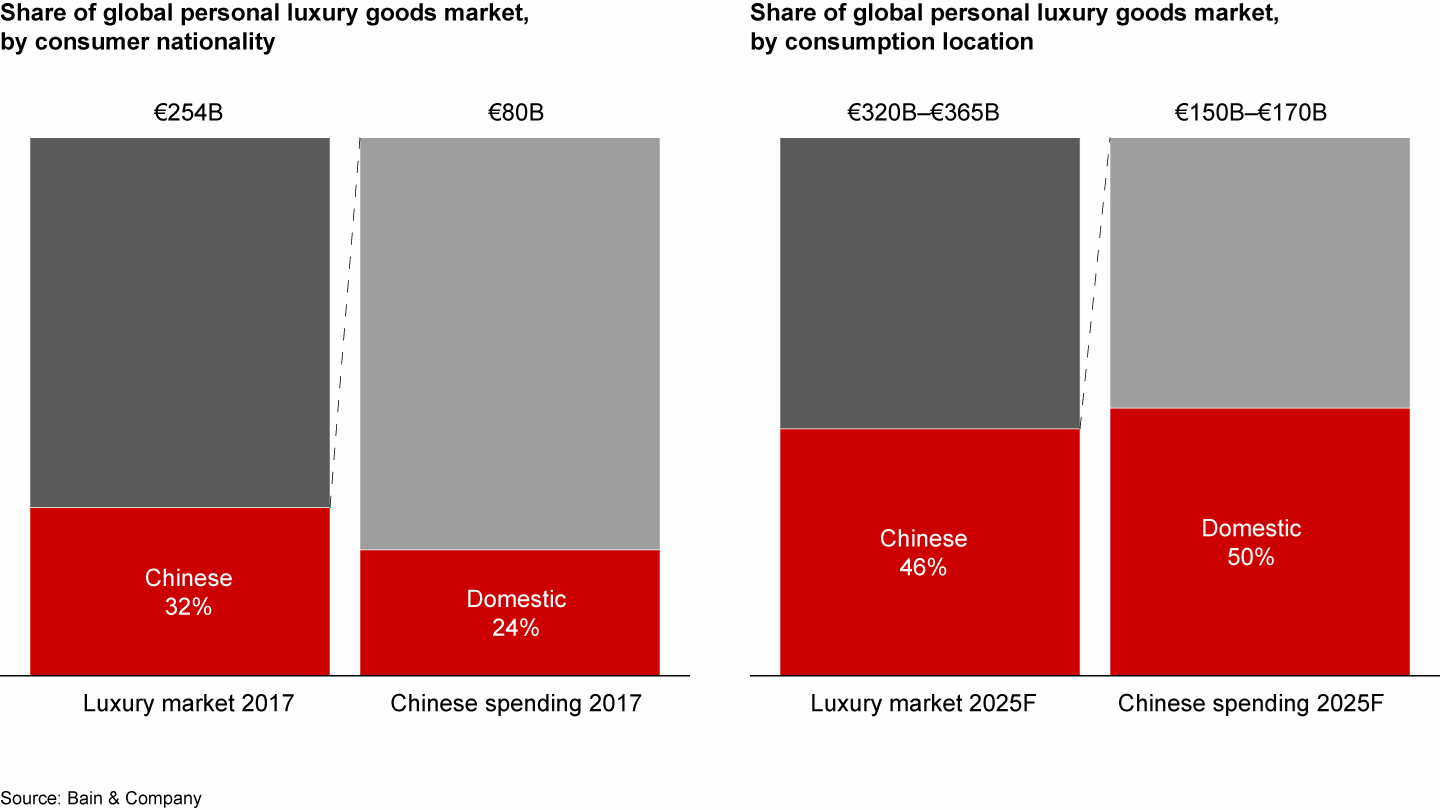
Generations Y and Z will represent 55% of the global personal luxury goods market in 2025

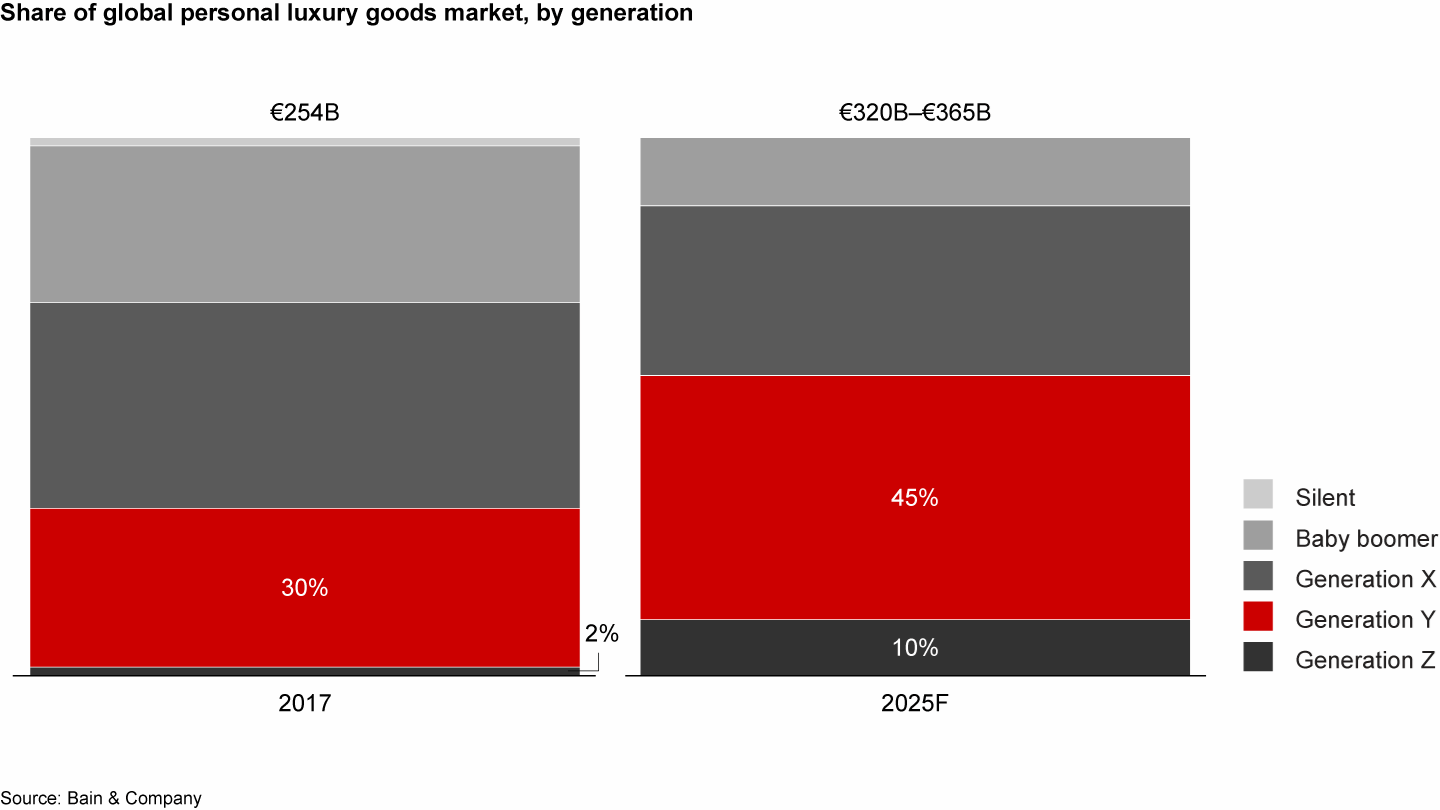
Online sales should reach 25% penetration by 2025


Profitability is likely to stabilize around 20% in the coming years


Appendix
About the Bain Luxury Goods Worldwide Market Study
Bain & Company analyzes for Fondazione Altagamma the market and financial performance of nearly 300 leading luxury goods companies and brands. This database, known as the Luxury Goods Worldwide Market Observatory, has become a leading and much-studied source in the international luxury goods industry. Bain has published its annual findings in the Luxury Goods Worldwide Market Study since 2000. The study’s lead author is Claudia D’Arpizio, a Bain partner in Milan. Fondazione Altagamma is led by Andrea Illy, who was named chairman in 2013.
Methodology of the study


Market restatement


Claudia D'Arpizio (claudia.darpizio@bain.com) is the global leader of the Luxury and Fashion vertical at Bain & Company. Federica Levato (federica.levato@bain.com) is a leading member of the Luxury and Fashion vertical. Both are Bain partners based in Milan.
Filippo Prete (filippo.prete@bain.com) is a manager, and Elisa Del Fabbro (elisa.delfabbro@bain.com) is a consultant, both in Bain’s Milan office. They also work with the firm's Luxury and Fashion vertical.
Joëlle de Montgolfier (joelle.demontgolfier@bain.com) is the practice area senior director for Retail, Luxury and Consumer Products in Europe, the Middle East and Africa. She is based in Bain’s Paris office.